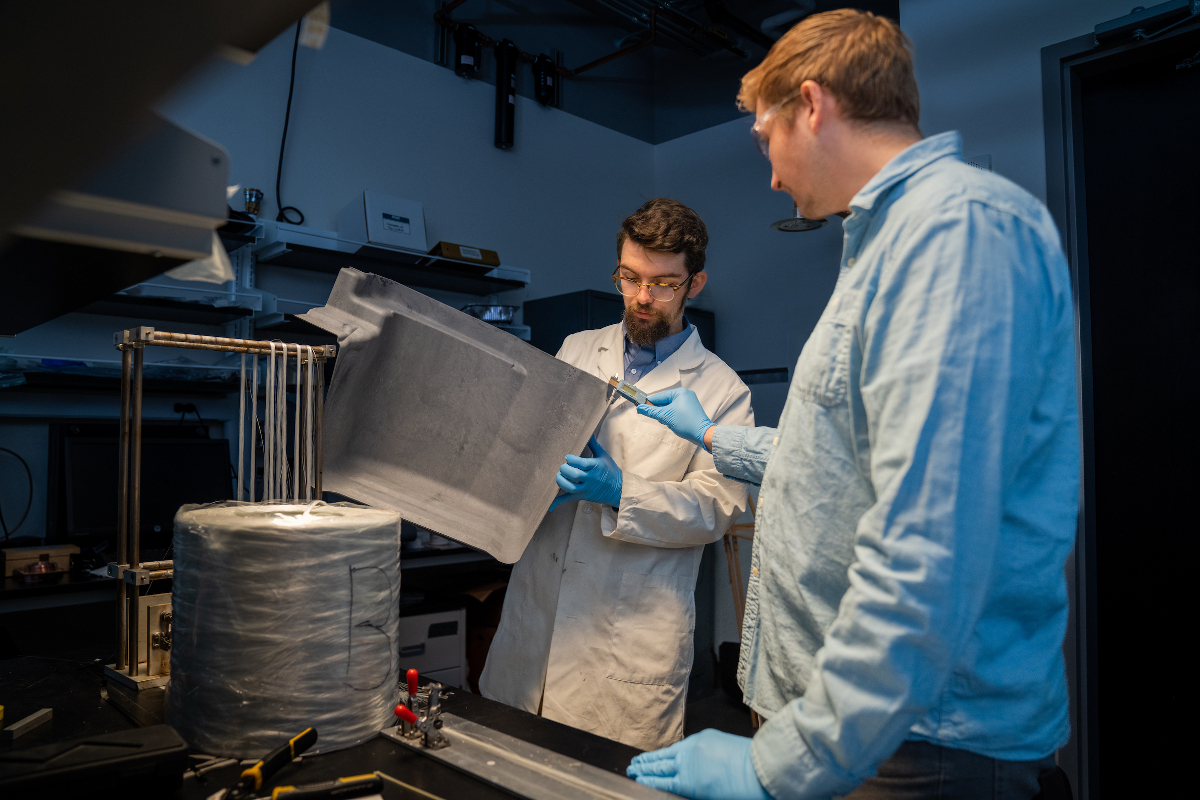
Anthony Colin Bruce Chapman, founder of Lotus Cars in 1952, had a favorite expression — “Adding power makes you faster on the straights. Subtracting weight makes you faster everywhere.” Chapman was famous for subtracting weight, often to the point of failure. Today, Volkswagen Group is also engaged in subtracting weight from its cars, not to make them faster (although that helps, too) but to make them more efficient, especially their battery-powered models.
In 2020, Volkswagen of America established its Innovation Hub at the Tennessee Research Park at Cherokee Farm in Knoxville. It focuses on applied materials science in collaboration with the University of Tennessee and Oakridge National Lab. The integrated teams are searching for breakthroughs in lightweight composites, recyclable interior materials, and EV wireless charging.
“We are accelerating innovation within electric vehicles and contributing to more sustainable transportation in America by focusing our efforts on some of the most transformative automotive research being done in the country,” said Pablo Di Si, President and CEO at Volkswagen Group of America, in a press release. “Our technology teams in Tennessee are a great example. There, we are tapping American ingenuity fostered by the unique blend of world-class academic research and Volkswagen’s leading industry capabilities. Centering more knowledge in the United States is part of Volkswagen’s strategy for growth and is vital for sourcing and developing talent,” Di Si added.
University of Tennessee chancellor Donde Plowman said, “The Volkswagen Innovation Hub is a powerful example of the kind of scientific advances and industry-ready technology that you can bring to market when you locate scientists and researchers from across disciplines and organizations together in one place. With partners like Volkswagen, Oak Ridge National Lab, and other industry leaders and tech startups located at UT’s Research Park, we have created a thriving innovation ecosystem.”
AI-Optimized Material Structures Research At Volkswagen
Every EV battery pack is encased within a robust steel shell that protects it from the elements and road hazards like trees, rocks, and the pig iron that falls off tractor trailer trucks from time to time. In order to offer the necessary level of protection, that shell is thick and strong — and heavy. The researchers in Tennessee wondered if there was a way to make a strong shell that would also be light in weight. It turns out, there is.
Using artificial intelligence to run a deep learning algorithm with up to 10 million parameters on the University of Tennessee’s high performance computer cluster, the team developed a modular repeating structure that uses tiny pyramids. This structure can be 3D-printed from liquid resins and holds 30,000 times its own weight. A newly created frame is up to 60% lighter, which is some serious weight reduction. Hardcore durability tests showed that it exceeds the conventional steel frame in energy absorption, which means it could serve as a lightweight, ultra robust alternative to a conventional steel frame.
Recyclable Interior Materials
The hub team at UT’s Center for Renewable Carbon is developing recyclable alternatives to plastic parts and foils in the vehicle interior. Their focus of their research is on using paper. The team has patented a method of preforming and hot pressing cellulose fiber–reinforced thermoplastics into the durable interior parts customers expect.
These paper based composites are not only recyclable, they can be transformed into various interior shapes and sizes, including those that are backlit or offer ambient lighting options. The team has also innovated ways to add different textures and colors, so vehicle interior designers enjoy flexibility and creative freedom. The Volkswagen brand is already exploring opportunities to include these paper based interior parts in future models and is learning how to manufacture them in large scale production.
New Lightweight Fiber Composites

Fiberglass-reinforced plastic panels. Courtesy of Volkswagen
The Volkswagen team began its lightweight materials research with UT by recreating the lift-gate of a 2020 Volkswagen Atlas using sheet molding compound — a type of fiberglass-reinforced plastic — instead of steel. The SMC lift gate is 13 pounds lighter than the conventional steel version. That’s a weight reduction of more than 35%. Granted, 13 pounds will have an infinitesimal impact on the a vehicle that weighs close to 2 tons, but imagine replacing the roof, hood, door skins, and fenders of an electric car with this material.
Now you are talking about a vehicle that is hundreds of pounds lighter. Less weight means smaller brakes and less beefy suspension components, which adds up to even more weight reductions. Better yet, the composite lift-gate does not need changes in assembly sequence, which means no expensive refitting of the factory in order to use it in actual production at high volumes.
This new SMC material has already found its way into vehicle production. Bentley and Lamborghini have adopted it and the molding process for use in the Bentley Continental and the Lamborghini Aventador. The team in Knoxville has also started a research project to explore lightweight options for pickup beds and rugged components.
Volkswagen and UT researchers have further refined molding processes and ways to optimize durability, quality and design options. One specific take is to optimize the fiber-matrix-interface, a process called “sizing” — essentially creating the smoothest, most durable coat for fibers possible.

High Power Wireless Charging
The Volkswagen team has recently patented a unique wireless coil and charging pad design with silicon carbide materials to optimize charging speed and safety. Their goal is to make charging an electric vehicle as easy and comfortable as pulling into a normal garage spot.
In early trials with a silicon carbide inverter, the prototype system has already shown it is capable of high efficiency. Using Volkswagen’s expertise in vehicle power electronics, ORNL’s capabilities in high power wireless charging, and UT’s knowledge of power electronics optimization, the research team has been able to increase the charging power level up to 120 kW with this prototype from an earlier 6.6 kW prototype. The ultimate goal is 300 kW, although other researchers claim 500 kW is possible. It is interesting that this news comes so soon after Tesla announced it is purchasing a wireless charging company.
120 kW from a wireless charger would be exciting news. 300 kW would be fantastic. Around the campfire in the backyard at CleanTechnica headquarters, we have to ask ourselves what the implications of wireless charging for V2H and V2G applications are. The answer is, nobody knows for certain sure, but bi-directional wireless charging sounds like it could be a dream come true.
I don’t like paywalls. You don’t like paywalls. Who likes paywalls? Here at CleanTechnica, we implemented a limited paywall for a while, but it always felt wrong — and it was always tough to decide what we should put behind there. In theory, your most exclusive and best content goes behind a paywall. But then fewer people read it! We just don’t like paywalls, and so we’ve decided to ditch ours. Unfortunately, the media business is still a tough, cut-throat business with tiny margins. It’s a never-ending Olympic challenge to stay above water or even perhaps — gasp — grow. So …
Sign up for daily news updates from CleanTechnica on email. Or follow us on Google News!
Have a tip for CleanTechnica, want to advertise, or want to suggest a guest for our CleanTech Talk podcast? Contact us here.
Former Tesla Battery Expert Leading Lyten Into New Lithium-Sulfur Battery Era:
CleanTechnica uses affiliate links. See our policy here.



